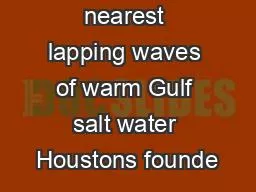

sandbars without protected harbors Galveston was the best natural port along the coast its hay protected hut shallow flushe Channel that kepi the passage clear of sandbars Buffal 18Ux0000 brothers ID: 892150
Download Pdf The PPT/PDF document "from the nearest lapping waves of warm G..." is the property of its rightful owner. Permission is granted to download and print the materials on this web site for personal, non-commercial use only, and to display it on your personal computer provided you do not modify the materials and that you retain all copyright notices contained in the materials. By downloading content from our website, you accept the terms of this agreement.
1 from the nearest lapping waves of warm G
from the nearest lapping waves of warm Gulf salt water, Houston's founders and fathers always dreame primarily as a port city. And strangely enough, despite being situated in the least auspicious of locations, through political persistence, geographic fortuity, and a few turns of historical hap-penstance, I louston did eventually become a successful deep-water port, the sixth largest in the world and, in the U.S., first in foreig waterbomc tonnag and second in total tonnage. The port and its associ-ated industrial /one, providing trade con-nections around the world, are the engines that drive I iotistnu's prosperity. Economic success, however, comes at a cost. Making the port has involved recurrent large-scale restructurings ol the landscape and .ilu ration sand-bars, without protected harbors. Galveston was the best natural port along the coast, its hay protected hut shallow, flushe Channel that kepi the pas-sage clear of sandbars. Buffal 18U-�
2 0;, brothers Augustus and John Allen, a
0;, brothers Augustus and John Allen, a pair of real-estate promot pushed fa Buffal instigation, th viaduct. No cotton an dee growing eastward. Meanwhile, the rebuilt 1'ort of Galveston was on five miles of wharf frontage, and new elevators and warehouses. It recovered quickly, an were cot-ton, fertilizer, lumber from east Texas, and sugar and rice from th coasta plains luck would have it, on January 10 l Texas. World War I demonstrate it develop-ment, fueling th demand tor petroleum products at th same time that ne th petroleum industry spawned th petrochemical indus-try, with new refineries processing raw stocks of petroleum, natural gas, and sulfur 10 produc new chemical wonders such as butadiene lor synthetic rubber, toluene fo you ar seriou ha tunnels, an ions in 2001, ranks second behind south Louisiana in total tonnage. Counted 111 tonnage, th lousto port's top trade partners ar Mexico, Venezuela, and Saudi Arabia. Counted in dollars,
3 total foreign trade is about $4 billion
total foreign trade is about $4 billion, with th th three parts: th old port neares louston, anchored it tin luriiing Basin; the p� (TO chemical port spread along th close to Galveston Bay fo easy access by large ocean-going ships, A slice through th histor the ol fertilizer sacks; the Sl,n i.lfui ol Panama unloading steel pipe onto a dozen waiting fl.itlx.-ds, with severa giani generators nearby on rail cars awaiting the return trip; th the gasoline used is the U.S. Tanker dock at corporate wharf facilities, unloading their crude car-goes from the Middle I .ist and South and Centra] Americ directly into th towns Ñ Galena Park, Pasadena, Deer Park, Texas City, Baytown, and La Porte Ñ provide home an suppor tor those who labor in th channe consists of new spe-cialized facilities, bu they ar not al one locale. These facilities exploit ne tech-nologies, combining specialized ships and loading equipment, that have completely changed th shippi
4 ng industry. From th -�!¥ hi idge
ng industry. From th -�!¥ hi idge, v mi i.in se the west the rotl-on/ro]|-off Ñ a.k.a RO/KO Ñ port. where ships from Germany disgorge ne shaped cargoes. At Jacintoport, there is a new cold storag and food distribution facility. Offshore, Ultra I arge ( rude ( arners an th bigges revolution in shipping is th ontaincr Terminal at Barbour's Cut, where Buffal louston, it wa not, on the t.iee ol it a shipping revolution. Bu anywhere in the world and ship it directly to a consumer anywhere else in th quickly, at low cost, and in relative security, th kind ol global com-merce was born. "Traditional ports, locate between 1 louston an eight feet wide; and eight feet tall (raised to eight feet six inches in th In- miiM common length eight high and ten wide. The weather deck provides a second cargo area, with containers stacked three to live high an wide. The third generation of container ships, built in the l9K0s and scaled to lit through th equiv
5 alents (TEUs) at about 14 knois. later s
alents (TEUs) at about 14 knois. later ship designs, ton large to pass through th the Pacific, th Atlantic, or th and South America come to I louston first, and their cargo ma that is, essentially, a parking lot. Usuall positioned fo inventory controls, bu still takes spectacular coordination betwee possible. The latest effort to reconfigure th with a projected 20 year build-out. Th container an Th s group, the Galvesto Association, notes that many of th made in th Corps of Engin-eers' draft environmental impact statement bias th site selection to Bayport. The Association suggests instea placin the proposed container terminal, stripped of it ship port, on on tens of million ol dollars, an land restructuring tor th channeling and processing a complex network of solid an via-bility and structure ot the network. The flow will always occur along the least expensive path. That path, by historical happenstance and entrepreneurial verve, has tor t